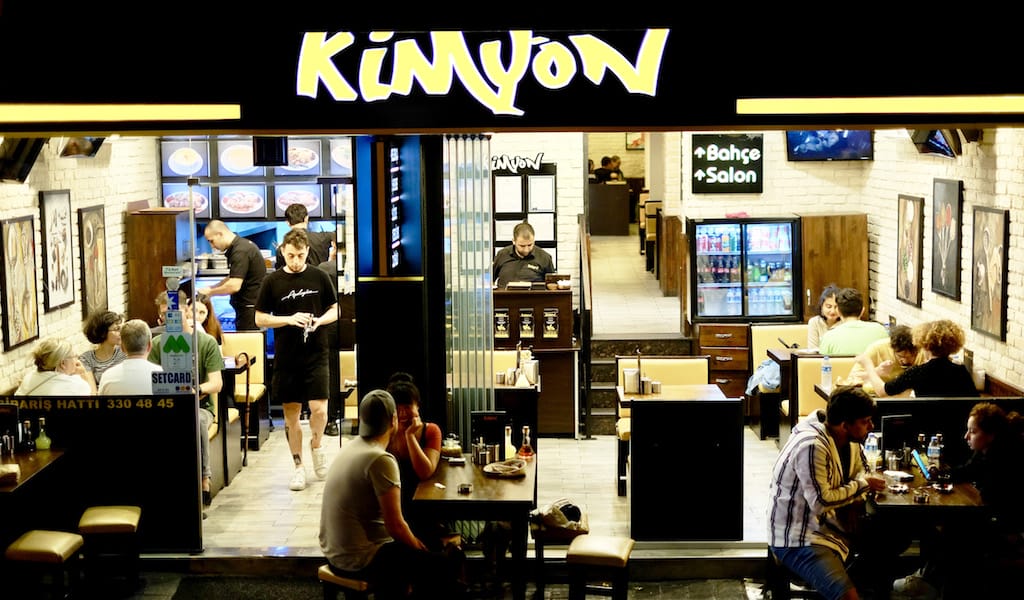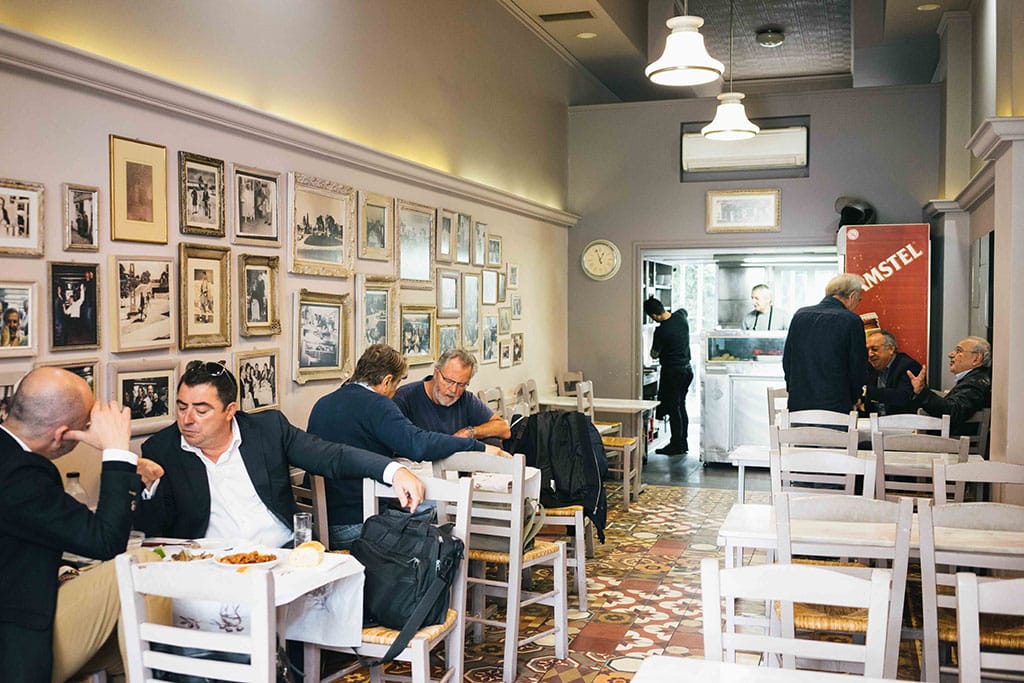Standing behind the counter at his small bici bici shop in Gökalp Mahallesi, a neighborhood in the Zeytinburnu district of Istanbul, Cuma Usta recalls the first time he headed up into the mountains with his uncles in search of wild ice, one of the key ingredients in this Turkish snow cone treat sold from street carts throughout southern Turkey. His uncles had gone up in the winter and cut large slabs of ice from the mountaintop, wrapped it in old blankets and hauled it off with a donkey to a nearby cave. In July, with young Cuma – just being introduced to the ways of bici bici – in tow, they headed back to the cave to collect the ice. It took a couple of hours by car, as he recalled, and the ride back to Adana, vehicle loaded with the frozen bounty, was nice and chilly. Then they’d use that ice to make the summertime street food favorite bici bici (pronounced like the disco-era band of brothers from Australia) and sell it from pushcarts. According to tradition, a bici bici master is, firstly, a harvester of ice.
“Mountain ice is softer. Factory ice,” he said, pointing to a pristine chunk freshly liberated from a plastic wrapping, “it’s been ‘shocked’ so it’s hard. Not as good.”
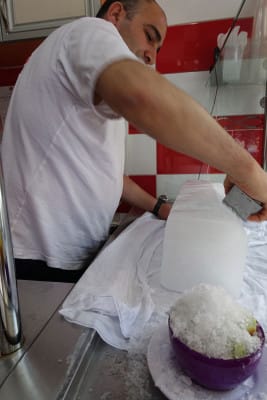 But Cuma Usta, in the bici bici trade for 30 years now, 20 of which in Istanbul, far from his mountain ice sources, has adapted. He now works from a shop, not a pushcart, and he gets his ice delivered from a distributor. “In the old days, bici bici was flavored by effort, but not so much anymore,” he said.
But Cuma Usta, in the bici bici trade for 30 years now, 20 of which in Istanbul, far from his mountain ice sources, has adapted. He now works from a shop, not a pushcart, and he gets his ice delivered from a distributor. “In the old days, bici bici was flavored by effort, but not so much anymore,” he said.
But, anyway, Cuma continued, it’s not all about the ice. “The secret is the rosewater şerbet,” he explained.
Şerbet is a sweet drink made by watering down a syrup, usually made from fruit, and then served cool. That might sound like some kind of “artisanal” Kool-Aid, but şerbet culture in Turkey runs very deep, and the drink enjoyed a particularly favored position in the Ottoman court. Şerbet and its elaborate service are depicted in Ottoman miniature paintings. Though şerbet is usually fruit-based, tamarind şerbet appears after a birth, and bitter herbs and honey are used for a syrup that’s part of the Hidrellez festival in spring. In many restaurants around Istanbul, house-made varieties appear on the daily specials board. Şerbet is serious business.
Similar regional snow cones may employ any number of different şerbets, but bici bici as it’s made in Adana calls for rosewater syrup. Cuma Usta spares no expense in sourcing his from the petals of fragrant Isparta roses – the one decadent, Ottoman flourish in what is otherwise a dessert made for the common man.
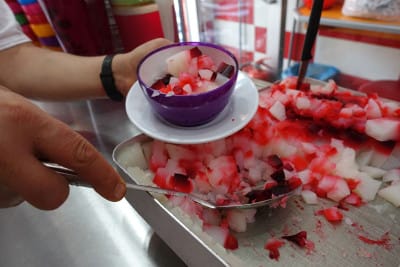 This şerbet is not only drizzled all over the shaved ice; it is also used to stain the surface of the pudding that goes on the bottom. That’s right, there’s a gelatinlike pudding on the bottom. Shove your spoon down to the bottom of the bowl and up come jiggly cubes of su muhallebisi, a water- and cornstarch-based pudding, sometimes white, sometimes beet-red from the syrup.
This şerbet is not only drizzled all over the shaved ice; it is also used to stain the surface of the pudding that goes on the bottom. That’s right, there’s a gelatinlike pudding on the bottom. Shove your spoon down to the bottom of the bowl and up come jiggly cubes of su muhallebisi, a water- and cornstarch-based pudding, sometimes white, sometimes beet-red from the syrup.
Su muhallebisi, shaved ice and rosewater şerbet make up the classic bici bici. On a recent visit to Cuma Usta’s, two young men from a nearby purse shop walked in. “Extra şerbet, extra sugar!” said Metin, a young, bearded blonde from Izmir. Powdered sugar, though not included in the “classic” version, is quite standard, according to Cuma Usta. Metin explained that in his hometown he enjoyed bici bici constantly and the lack of it in Istanbul – Cuma Usta is among the few bici bici makers in this city – is a “major loss.”
Joining Metin and his colleague, we were persuaded by Cuma Usta to try a less traditional bici bici. First he covered the bottom of a bowl with little cubes of pudding, then we covered that with blackberries and kiwi fruit. Then he dragged a metal grater over the ice block, producing scoops of powdery shavings that he packed on top of the fruit. Then came a few shakes of powdered sugar and a generous pour of şerbet. No need for instruction; bici bici is best consumed quickly.
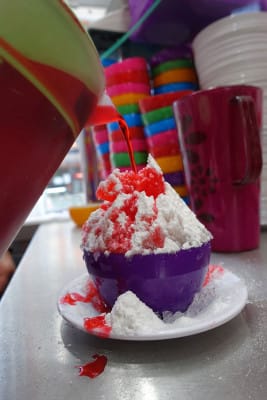 We love shaved ice on a hot summer day, with fruit, cool whip, vodka or whatever is on hand. Rosewater may remind us of a certain perfume worn in excess by an older sister in adolescence, and too much powdered sugar may mix with melting ice to create a waxy Diet Rite-esque sensation in the mouth, but bici bici, at its chilling core, is crunchy, ice-cold, fruity, sweet goodness consumed in a refreshing blur.
We love shaved ice on a hot summer day, with fruit, cool whip, vodka or whatever is on hand. Rosewater may remind us of a certain perfume worn in excess by an older sister in adolescence, and too much powdered sugar may mix with melting ice to create a waxy Diet Rite-esque sensation in the mouth, but bici bici, at its chilling core, is crunchy, ice-cold, fruity, sweet goodness consumed in a refreshing blur.
Is it better than the Hawaiian shave ice we had at Matsumoto’s? Can we compare it to the anticipation with which we waited every year for our first lemon ice at Mario’s on Taylor Street in Chicago? Sit around analyzing it too much and you’ll probably need a straw to finish your bici bici. One thing is for sure: This one has got the best name of any snow cone in the world. It’s worth the ride out to Zeytinburnu just to say “bici bici.”
Published on July 24, 2015
Related stories
Explore Kadıköy on our Two Markets, Two Continents walk!
September 26, 2019
IstanbulKadıköy’s Kimyon is a friend of the after-hours and the booze-fueled denizens who are done at the bar but have yet to call it a night. It is the buffer zone between too many drinks and a brutal hangover, and doesn’t judge those who are still up at 6:30 a.m., because it’s still open and…
November 1, 2017
AthensIt’s a quiet Tuesday lunchtime when we pass through Eleftheroton Square in Chalandri, one of Athens’s northern suburbs. Anyone living in the surrounding areas knows that this boisterous neighborhood is the best place to shop and go out, whether for a bite to eat or a drink. From small, quiet bars to gourmet restaurants, from…
February 15, 2016
QueensThe story of how Queens transformed into a microcosm of the world’s cuisines is just as fascinating and important as those of the cuisines’ creators. The borough is one of the most diverse places on the planet, with over 120 countries represented and 135 languages officially spoken in the public school system. The cause? The…














































